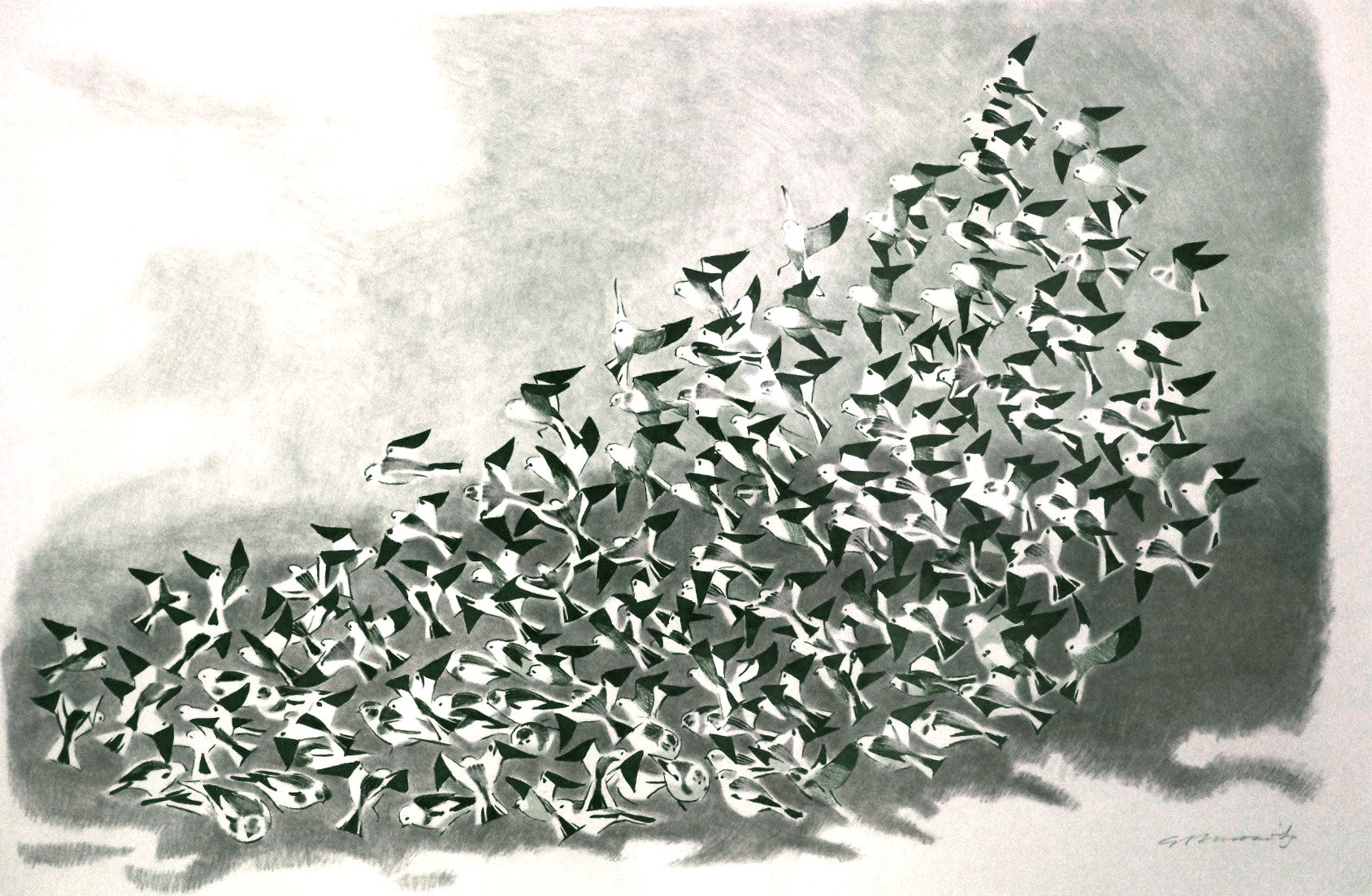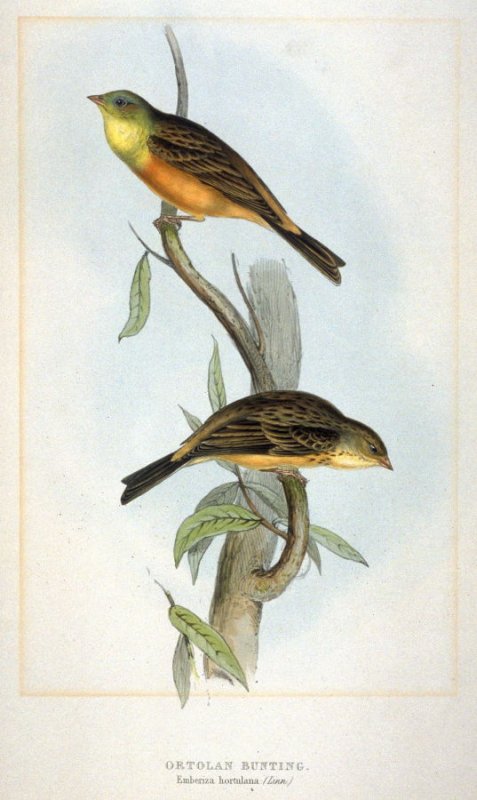[This is a greatly expanded and edited version of an article I wrote for the 7th Annual Newsletter of the Canadian Snow Bunting Network (online here), sent out a couple of weeks ago]
In 1981, during my first high arctic field season, my incomparable group of graduate students and field assistants [1] saw some great opportunities for studying the breeding biology of birds at close range [2]. With the ability to follow birds continuously on the open tundra, they realized the potential for answering some interesting questions about sexual selection and parental care that had proven difficult to study with the more skittish temperate and tropical birds that we were all familiar with. Bruce Lyon, now at UC Santa Cruz, focussed on Snow Buntings so we began by trapping birds, using both potter traps and noose carpets. I already had a little experience trapping Snow Buntings in Ontario in winter with David Hussell, so we were quite successful in catching the mated pairs on our study area at Sarcpa Lake, Nunavut. Little did we know at the time that the Snow Bunting had been trapped for food long before scientists began catching it for research.

My wife’s mother grew up during the 1930s in Sept-Îles on the north shore of the St Lawrence River in far eastern Québec. When I first met her in the mid-1990s, and told her about my high arctic research, she rather sheepishly admitted that her family used to catch Snow Buntings with noose carpets in the winter, to provide a little fresh protein and fat for their limited diet. Even in the 20th century, the fur trappers of Labrador were said to have: lived on a healthy diet of spruce partridge, caribou steaks, ptarmigan stew, snow buntings, salt pork, and flat bread made of flour, salt and water cooked in an open pan over the fire. [3]
This little bird has in fact been an important food source for people throughout its winter range, shot—and trapped with noose carpets, box-and-stick, grain sieves, and drag ropes—wherever they were abundant [4]. In 1903, for example, a State game warden found nearly 80,000 snow bunting carcasses in a cold storage warehouse in a ‘large eastern’ city of North America, ready to ship to local markets and restaurants [5].

In the late 1700s, the great English explorer and naturalist Samuel Hearne wrote extensively about the birds and mammals he encountered on his expeditions through northern Manitoba and Nunavut. Many of his observations were unique and perceptive, demonstrating an appreciation of ecology and behaviour well ahead of his time [6]. But he also described how to hunt or catch each species and its suitability as food, thereby providing a guide to other explorers who would have to live off the land—an 18th century version of TripAdvisor or Yelp. Here is what he said about the Snow Bunting:
These birds make their appearance at the Northern settlements in the Bay about the latter end of May, or beginning of April, when they are very fat, and not inferior in flavour to an ortolan…At that time they are easily caught in great numbers under a net baited with groats or oatmeal; but as the Summer advances, they feed much on worms, and are then not so much esteemed [as food]. They sometimes fly in such large flocks, that I have killed upwards of twenty at one shot, and have known others who have killed double that number…In Autumn they return to the South in large flocks, and are frequently shot in considerable numbers merely as a delicacy; at that season, however, they are by no means so good as when they first make their appearance in Spring. [7]

The ‘ortolan‘ that Hearne refers to here is the Ortolan Bunting (Emberiza hortulana) that breeds throughout eastern Europe and west-central Asia to western Mongolia. Since the 1930s their numbers have declined markedly in western and northern Europe, largely due to increasing intensity of agriculture but also because they have been trapped for food. Even though trapping and killing endangered birds is illegal in the European Union, poachers in France are alleged to be taking tens to hundreds of thousand of them per year for the restaurant trade and home consumption [8]. This species is not at all endangered but its numbers in western Europe and Scandinavia have been decimated in recent decades.
The ortolan has long been considered a culinary delicacy in Europe, particularly in France where they are still available illegally to people of wealth and power. Knowing that he had only a few days to live, French President François Mitterand [9] famously ordered (and received) two ortolans for his final, gluttonous meal. It is said that he died a happy man.
So, in retrospect, Samuel Hearne’s comparison of the Snow Bunting to the ortolan is incredible praise indeed. Almost a century before Hearne came to Canada to work for the Hudson Bay Company, Father Chrestian Le Clercq, a Franciscan missionary, called the Snow Bunting ‘ortolan’ in his book on Québec’s Gaspé Peninsula [10]. We don’t know, however, if LeClercq used that name because of the bird’s flavour or its appearance. Linnaeus noted that the Snow Bunting was called ortolan de neige in France, and that may well have been why the name was familiar to LeClercq.
We can be grateful that the conservation of birds became a cause early in the 20th century because, even as that century began, it was clear to some that the Snow Bunting could not stand the sort of hunting pressure they were subjected to in eastern North America. Here is Henry Dutcher in his 1903 report: It is to be hoped that they will not become in demand to supply the market, else, from the readiness with which they can be captured, we should look for the early extinction of the most agreeable feathered companion which the northern residents possess during their long, tedious winters. [11]
SOURCES
- Anonymous (1876) The Snow Bunting. American Agriculturalist 35:253.
- Cockerill AW (2004) The trappers of Labrador. Material Culture Review / Revue de la culture matérielle 60: (available here)
- Dutcher W (1903) Report of the AOU committee on the protection of North American birds. The Auk 20:101–159.
- Ganong WT (1910) The identity of the animals and plants mentioned by the early voyagers to Eastern Canada and Newfoundland. Transactions of the Royal Society of Canada 3: 197-242.
- Hearne S (1795) A Journey from Prince of Wales’s Fort in Hudson’s Bay to the Northern Ocean. London: Strahan and Cadell.
- Montgomerie R. 2018. The history of ornithology in Nunavut. pp 49-69 IN Richards JM, Gaston AJ. The Birds of Nunavut. Vancouver: UBC Press.
- Svanberg I (2001) The snow bunting (Plectrophenax nivalis) as food in the northern circumpolar region. Fróđskaparrit (Annales Societatis Scientiarum Faroensis) 48:29–40.
Footnotes
- my first arctic field crew: Of the 6 graduate students and field assistants that came north with me in 1981, four went on to successful academic careers as university professors (Lyon at UC Santa Cruz, Mary Reid and Ralph Cartar at Univ Calgary, and Rob McLaughlin at Univ Guelph), and one became a medical doctor (Linda Hamilton). It amazes me how lucky I was to start my own academic career with such a fun and engaged crew.
- observing at close range: because there was really nowhere for the birds to hide we sometimes followed individuals around the clock in an attempt to document rare behaviours (like extrapair copulations) that are so hard to see in passerines that breed in forests and grasslands
- quotation about trappers: from Cockerill (2004)
- snow bunting traps: see Svanberg (2001) for more details and a summary of the snow bunting as food particularly in Scandinavia, Iceland and the Faroe Islands
- 80,000 snow bunting carcasses: information from Dutcher (1903)
- Hearne’s observations ahead of his time: see my chapter in Birds of Nunavut (Montgomerie 2018)
- Hearne quotation: page 419 in Hearne (1795)
- poachers in France take 10 thousand or more ortolan per year: see, for example, articles in 2013 in the Guardian here, and in a 2014 blog post here
- François Mitterand: was president of France from 1981-1995. During his second term he was diagnosed with terminal prostate cancer, to which he succumbed 8 days after that final meal, a meal that included, in addition to the roasted ortolans, capons, foie gras, and a platter of Marennes oysters.
- ortolan on the Gaspé: see page 228 in Ganong (1910)
- quotation about conservation: from Dutcher (1903)IMAGES: original print of snow buntings in winter from the author’s collection; traps from Svanberg (2001); Gould’s Ortolan from his Birds of Europe; Audubon’s Snow Bunting from his Birds of North America
Congratulations!
I have nominated your blog for the Real Neat Blog Award.
More about this nomination is at
https://dearkitty1.wordpress.com/2018/12/09/real-neat-blog-award-congratulations-seventeen-nominees/